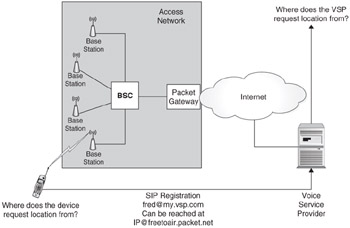Location in an Open Services Network
In this section, we will look at the case of voice services being provided by an operator that is independent of the access network provider. This should be treated as an example only and may be equally applicable to a range of other services, such as those related to presence.
The need for a LIS in an IP access network is clear because without it there is no way to obtain location (see Figure 8.10), and without location, some services (emergency services amongst them) either won't work well, or won't work at all.

Figure 8.10: An access network conundrum.
In a wireless network, even if the mobile device is able to obtain a location from the network, the location needs to be fresh, and this results in it having to be determined at the time of each call in order to ensure that the location the mobile has is still correct. While some devices can determine their own location, most cannot, and those that can, often require assistance in the form of data provided by the network-A-GPS, for example. Providing a literal location at periodic intervals to the mobile is not a viable solution in most cases. First, to ensure a consistent level of precision, the rate at which data are pushed to the mobile needs to be directly associated with how fast a Target is moving, and for a large network with hundreds of users this is likely to be computationally impractical. Second, and perhaps more importantly, location data aren't required for all services, it is only necessary for the relatively small set of services that are tied to the physical location of a device at the time the service is requested. Since location information needs to be fresh, is relatively expensive to compute, and is not required for all services, it makes a lot of sense to compute it only when it is requested-that is, to use a location URI.
To use a location URI in wireless data networks, a LIS is needed. The LIS will determine the location of the device within the access network only when requested to do so and it may use any one of, or a mixture of, the following: ALEs, control-plane, user-plane, general network, and device-based measurement location techniques.
Figure 8.11 shows the IP Location architecture for a fully mobile data network. The LIS operates inside the access network, and the mobile device establishes a HELD context with the LIS, which includes an access rule that allows the mobile's voice service provider (VSP) access to the mobile's location information. The mobile device then registers with its VSP and includes the location URI in the registration message. Consequently, the mobile does not need to be aware of which services require location information and which do not; this decision is left to the VSP whose role it is to determine routing information for the requested service.

Figure 8.11: Wireless access location solution.
EAN: 2147483647
Pages: 129